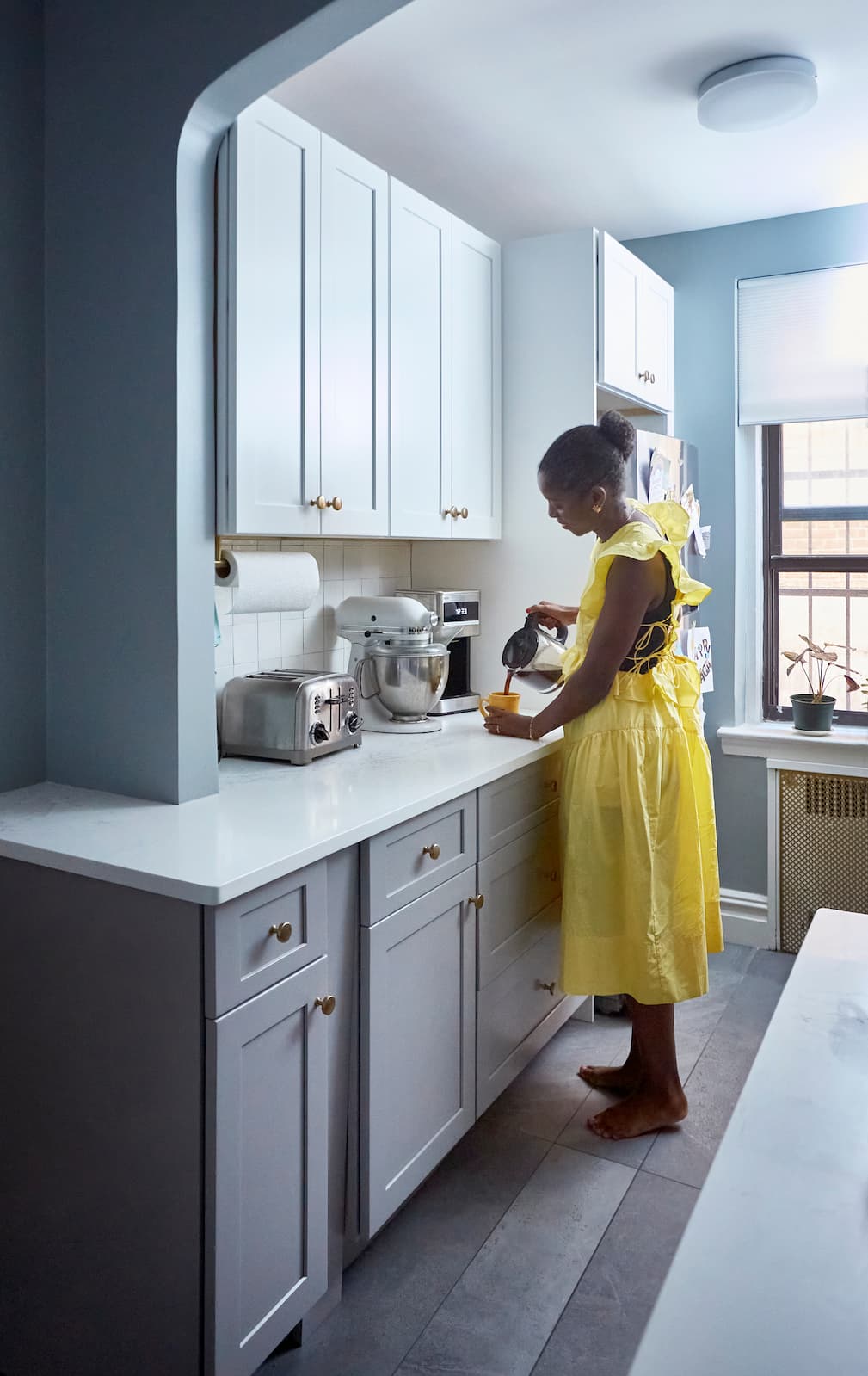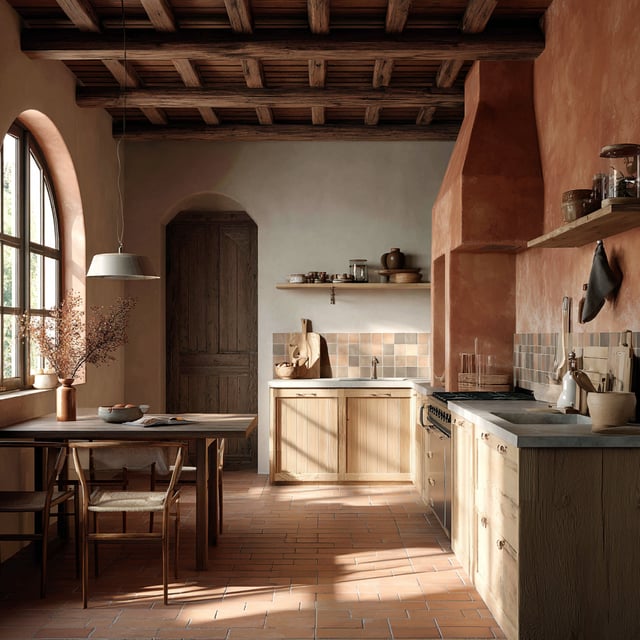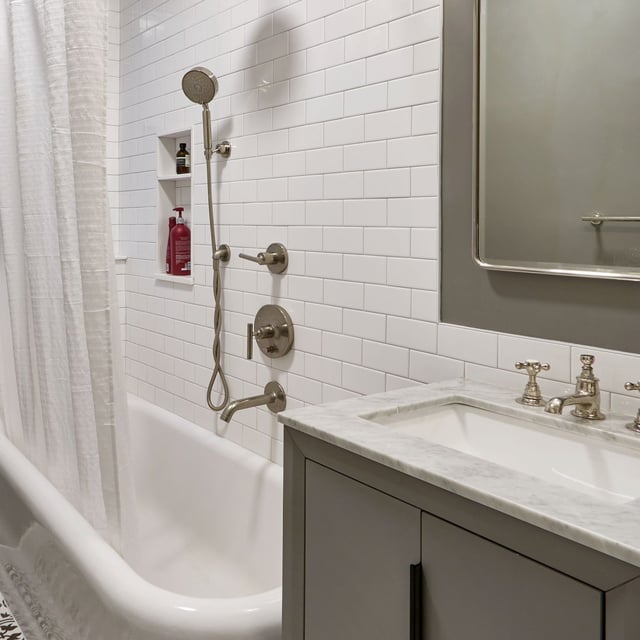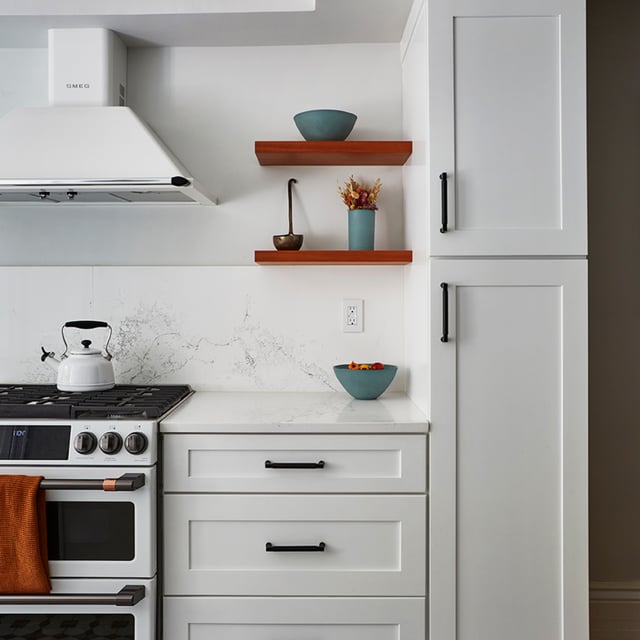
Design
Mid-Century Modern House Remodels & Design Ideas
11.22.2025


In This Article
When space is tight, layout decisions matter more. That’s where open concept design becomes less of a style choice and more of a strategic move. Removing walls between the kitchen and living area can dramatically improve how a small home feels—and functions.
In an 800-square-foot apartment or a narrow townhouse, the shift is immediate. Natural light travels farther. Sightlines open up. And what once felt compartmentalized now feels livable, even social. A cramped galley kitchen becomes part of the conversation, not a space you disappear into while everyone else gathers elsewhere.
It’s not just about aesthetics. For families, open layouts make multitasking easier—you can prep dinner while keeping an eye on kids or guests. For frequent hosts, it removes the friction of cramped entertaining. And for many homeowners, it’s a way to make a modest footprint do more without adding square footage.
But creating an effective open layout in a small home requires careful planning. It’s easy to overdo or overlook details that impact flow, storage, or structural needs. Below, we’ll cover design principles and practical solutions that make small-space open concepts work—and work well—for daily life.
Turn your renovation vision into reality
Get matched with trusted contractors and start your renovation today!
Find a Contractor
While open floor plans offer incredible benefits, they do come with a few challenges that smart design can address. Without walls to contain them, cooking smells and noise travel throughout your home. Storage can become an issue when you lose the cabinets and closets that walls typically provide. Privacy becomes harder to achieve, and temperature control can be trickier in one large space versus separate rooms. The good news? Each of these concerns has design solutions that let you keep all the benefits of open living while addressing these practical considerations.
Smart built-ins are key to making open layouts work, especially in small homes where storage can’t come at the cost of space. Floor-to-ceiling cabinets along one wall offer plenty of hidden storage without crowding the room. A kitchen island pulls double duty too, with deep drawers that keep essentials within reach while maintaining clean lines. Even a window seat can work harder, offering a cozy spot to sit with storage tucked underneath. And elements like built-in bookshelves or media walls can help subtly divide the space while keeping things tidy and intentional rather than cluttered.
Strategic design choices can significantly reduce how sound travels through your open floor plan, creating more comfortable living for everyone. Incorporate soft materials like upholstered furniture, area rugs, and fabric window treatments that naturally absorb sound rather than reflecting it. Consider acoustic panels disguised as artwork, or add a large bookcase filled with books, which acts as both storage and sound absorption. Furniture placement plays a role too—positioning a sofa or console table can create natural sound barriers between your kitchen workspace and living area, allowing for conversation in one zone while someone cooks in another.
Sometimes you need the option to create separate spaces within your open floor plan, and flexible dividers give you that choice without permanent walls. Sliding barn doors or pocket doors can close off the kitchen during meal prep or hide post-dinner cleanup when entertaining. Room-height curtain panels on ceiling tracks offer another option—they're nearly invisible when opened but provide instant privacy when drawn. Large, mobile pieces like bookcases on wheels or folding screens can be moved as needed, giving you the flexibility to adapt your space for different activities or occasions.
Open layouts feel airy, but they can be harder to heat and cool evenly. The fix is in smart planning. Ceiling fans in both the kitchen and living area help air circulate so you’re not overworking your HVAC. Zoned systems let you control temps by area—useful when the kitchen heats up while cooking. Layered window treatments give you control over sunlight and insulation, and soft elements like rugs or upholstered furniture add warmth where it’s needed, both literally and visually.
In an open layout, lighting defines the room. Pendant lights over the kitchen island mark the cooking zone, while a chandelier above the dining table creates its own moment. Table and floor lamps bring a softer glow to the living area, making it feel distinct from the kitchen’s task lighting. And with dimmers throughout, you can shift the mood as needed—bright for cooking, low and relaxed for evenings.
A unified color scheme ties your open space together while allowing for subtle variations that help define different functional areas. Start with a neutral base for walls and larger furniture pieces, then add personality through accent colors in pillows, artwork, and accessories that appear throughout the space. You might use deeper, richer tones in the living area to create coziness, while keeping kitchen areas lighter and brighter for an airy feel. This approach creates visual flow that makes your space feel intentionally designed rather than like separate rooms that happen to be connected.
Architectural details can quietly define zones in an open layout and bring in character that blank, open spaces often lack. A coffered ceiling over the dining area or exposed beams stretching from kitchen to living room create subtle visual breaks. Half-walls with built-in seating or simple columns offer separation without closing things off. Even a shift in ceiling height—taller in the living room, standard in the kitchen—can signal different zones while keeping the flow intact.
Built-in seating adds comfort and storage without crowding your space. A wall-length banquette can seat more guests than chairs and keeps essentials tucked neatly underneath. Window seats turn overlooked corners into inviting spots to read or relax, no extra furniture needed. These custom touches don’t just look built-in—they work harder, blending form and function in a way that standalone pieces often can’t.
A high-quality range hood becomes essential in an open floor plan, where cooking smells can quickly spread throughout your entire living space. Choose a hood that vents directly outside rather than simply recirculating air, and size it appropriately for your cooktop—it should be at least as wide as your cooking surface. Consider a downdraft ventilation system if an overhead hood doesn't work with your design, or explore ceiling-mounted options that provide powerful suction without overwhelming your kitchen's visual flow. Proper ventilation not only manages odors but also helps control grease and moisture that could affect your entire open space.
Not sure how to begin your renovation?
Get free, expert guidance from a dedicated Block Project Planner who can help you navigate proposals, timelines, contractor selection, and more.
Book A Free Consultation
Natural light is your greatest ally in making a small open floor plan feel spacious and welcoming. Remove heavy window treatments in favor of light-filtering options like sheer curtains or cellular shades that provide privacy while letting sunlight flood your space. Keep window sills clear of clutter, and consider adding mirrors strategically across from windows to reflect light deeper into your room. If your budget allows, upgrading to larger windows or adding a skylight can dramatically change how expansive your space feels.
Paint connecting walls in the same light color to create uninterrupted visual flow from kitchen to living area. This continuity tricks the eye into perceiving the space as larger than its actual square footage. Avoid abrupt color changes that chop up the space visually, and instead use varying shades of the same hue if you want subtle definition between areas.
When remodeling your small home’s open concept kitchen and living area, consider repainting walls, ceilings, and trim in a cohesive, light color palette. Soft whites, pale grays, or warm neutrals reflect more light and visually expand the space. Extending the same color across connected areas blurs boundaries, making the entire open floor plan feel larger and more harmonious. For added depth, use subtle variations of your main color on accent walls or built-in features.
Running the same flooring material throughout your entire open space creates seamless visual flow that makes the area feel larger and more cohesive. Hardwood, luxury vinyl plank, or large-format tiles work especially well because they create uninterrupted lines that guide the eye throughout the space. This continuity eliminates the visual breaks that different flooring materials create, helping your brain perceive the area as one large, connected space rather than separate rooms pushed together. When you want to define different zones, use area rugs or furniture placement rather than changing floor materials, which can make even large spaces feel choppy and smaller.
For more ideas to inspire your open floor plan design, read Small House Renovations: Solutions for Limited Space.
Transforming your home into an open concept space involves much more than simply removing walls. Load-bearing walls require structural engineering to ensure your home remains safe and sound after renovation. A structural engineer will need to assess which walls can be removed and design appropriate beam systems to carry the load that walls previously supported. You'll need permits for most wall removal projects, and the approval process can take several weeks depending on your local building department's workload.
Wall removal often affects electrical, plumbing, and HVAC systems that run through existing walls, adding complexity and cost to your project. Electrical outlets and switches will need to be relocated, and you may need to upgrade your electrical panel to support new lighting and appliance configurations. Plumbing vents and supply lines might require rerouting, especially if you're removing walls that contain these systems. HVAC ductwork will likely need modification to properly heat and cool your new larger space, and this is the perfect time to consider zoned climate control for better comfort and efficiency.
The renovation process typically takes 4-8 weeks depending on the scope of work and any complications that arise. Expect your kitchen to be out of commission during most of the project, so plan for alternative cooking and eating arrangements—many families set up temporary kitchens in basements or other areas of the home. Dust and noise are unavoidable during demolition and construction phases, and you'll want to consider how this impacts your daily routine, work-from-home schedules, and family life with children or pets.
Budget considerations extend beyond the basic demolition and reconstruction costs that might initially come to mind. You might discover issues like outdated wiring, plumbing that doesn't meet current codes, or structural problems that need addressing before you can proceed with your renovation. Factor in costs for new flooring that spans the entire open space—you'll likely need more square footage than you initially calculated. Updated lighting systems, new HVAC solutions, and potentially new appliances that work better in your open layout all add to the investment, but they're essential for creating a space that truly works for your lifestyle.
Design a Home That’s Uniquely Yours
Block can help you achieve your renovation goals and bring your dream remodel to life with price assurance and expert support.
Get Started
Transforming your separate kitchen and living spaces into the open, connected home you've been dreaming about requires the expertise of contractors who understand structural renovations and the complexities of creating successful open floor plans. Block connects you with vetted professionals who have successfully completed similar projects and can guide you through every step of the process.
Ready to move forward? Block matches your project with experienced contractors who specialize in open concept renovations. You'll receive competitive bids with detailed scopes of work, and our Project Planners guide you through the process to ensure your project stays on track and within budget while meeting all local building codes and requirements.

Written by Block Renovation

Renovate confidently with Block
Easily compare quotes from top quality contractors, and get peace of mind with warranty & price protections.
Thousands of homeowners have renovated with Block

4.5 Stars (100+)

4.7 Stars (100+)

4.5 Stars (75+)

Design
Mid-Century Modern House Remodels & Design Ideas
11.22.2025

Design
Cape Cod Remodeling Ideas & How-Tos
11.15.2025

Design
Modern Tuscan Style Kitchens to Inspire Your Next Redesign
10.23.2025

Design
Vintage Bathroom Remodels - Balancing Retro & Modern Design
09.18.2025

Design
Bringing Wood Elements Into the Kitchen: Walls, Countertops & More Ideas
09.05.2025
Renovate confidently